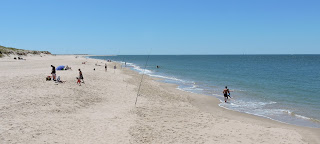 |
| Sarlat's cathedral at dusk |
While France's Burgundy and Bordeaux are the best-known wine regions, the south of France is lush with vineyards and full of excellent wineries. We met a close friend of my sister's at l'Hospitalet, a winery and hotel a few miles from the Mediterranean in the limestone highlands of Languedoc, near Narbonne. She is a marketing and strategic planning consultant with wide knowledge of French wines and superb contacts within the wine industry and she set up a great wine tour for us.
 |
| l'Hospitalet winery and vineyard |
We had a real education in biodynamic wines, a growing tradition in this part of France. After a tour of the vineyard, viewed with the Mediterranean as a backdrop from atop a high hill, we tasted 8 wines with full explanations of the growing and winemaking processes behind them.
L'Hospitalet's owner, Gerard Bertrand, has made a big commitment to organic/biodynamic winemaking throughout his 600 hectares of vineyards. Biodynamic wines go beyond organic in that the grapes are grown according to the rhythms of the moon and sun, winds and weather patterns in addition to using no pesticides, fertilizers or other chemicals. So, for example, if it rains when the harvest is underway, everyone waits for the winds (which always blow here) to dry out the grapes rather than dusting them with anti-fungal chemicals. The moon and sun part is a bit more complicated, but essentially the concept is to use the natural environment in all its aspects to enhance the health and quality of your vines and, therefore, your wines. And, indeed, the wines are excellent.
 |
| 14th century merchants' houses in Sarlat |
France has very strict regulations if you want to qualify for the appellation d'orgine protegee (AOP), the creme de la creme of French winemaking. Each region has regulations that specify exactly how wines will be made, such as exact percentages of each kind of grape that goes into each blend. Irrigation is also forbidden so vines are at the mercy of the weather. I'm sure, if a drought actually threatened the vines, owners would water them and give up the AOP for that vintage in order to save their precious vines.
You can, of course, make wine any way you want, but only those wines made according to each region's regulations can get the appellation designation. Some winemakers are experimenting with different blends of grapes and different percentages of each grape. Some are even trying out new varietals. They make top quality wines, just no appellation.
 |
| Lantern of the Dead, Sarlat |
Next stop was Sarlat-la-Caneda, a pretty medieval town in Dordogne, full of tourists and beautiful, 14th century limestone buildings. During the incessant Medieval wars, Sarlat remained loyal to the king, who rewarded them with economic bounty. Prosperous merchants built tall, angular homes throughout the city which, along with its squares, are Sarlat's principle attraction today.
 |
| Peche Merle horse (borrowed from their brochure) |
Being in limestone country, Sarlat is surrounded by huge caves. We visited a particularly wonderful one, Grotte Pech Merle, which was occupied (or at least decorated) by Cromagnon people and enormous bears 11 feet tall, who dug holes in the floor of the cave for their winter hybernation.
 |
| cave of discs (also borrowed from Pech Merle's brochure) |
You can't take photos inside the cave, so I've borrowed from Pech Merle's brochure, but you can see where bears and hyenas scratched on its walls, glistening stalactites and stalagmites, and wonderful animals Cromagnons painted on the walls sometime between 23,000 and 29,000 years ago. There are mammoths, oryx, horses with tiny heads, buxom, pregnant women and bears. The best painting is of 2 horses surrounded by 6 hands and filled with dots about 2 inches in diameter. The artists used graphite to draw the outlines of the animals.
These were drawn on top of even older paintings that are red, presumably from iron oxide.
 |
| dog enjoying dinner with its owners |
Dogs are everywhere, including inside restaurants. For us dog lovers, that is rather charming. For U.S. health inspectors, that would be anathema. We have seen several very large Bernese Mountain
Dogs, which we love, since our dogs, Kili and Carson, are the 14th and 15th Berners to be part of our family over the last 45 years.
Our second day in Sarlat, we did a hike that ended up being about 10 or 11 miles instead of 7 because we lost our way amidst the narrow back roads and farm tracks. But, we saw farms, fields, old stone barns and houses and gorgeous gardens--well worth the extra trekking.











































